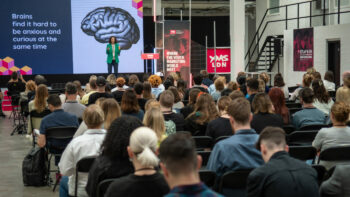
Communeconomy | The Future Of Youth Marketing
Article Highlights
- The future of youth marketing
- What is ‘communeconomy’?
- How does communeconomy impact your brand?
- Preparing for the future
- Key takeaways
Be the first to access new posts and exclusive content
Culture marketing and cultural marketing strategies have become the default for youth marketing. But when the culture that is often wielded for marketing purposes signals its retreat from corporate reach, what’s next for youth marketing?
Brett Booth, Voxburner advisory board member and youth marketing strategy consultant, shines a light on communeconomy and what this shift will mean for brands operating in the youth marketing space.
The future of youth marketing
Let’s start with the facts. More community-oriented social platforms like Discord are seeing a widely reported spike in user growth, largely driven by Gen Z’s seeking more private spaces to socialise and participate in the communities they belong to, while traditional social media is observing a shift in attitudes and behaviours away from the perceived norms of daily public broadcast.

In a recent project, in collaboration with the IoM/Identification of Music community, we reported that Discord had amassed 390M uses at an impressive 66% average year on year growth, whilst another player in the more community-centric digital space, Reddit, had reached 430M users with a year on year average growth rate of 30%.
As it stands, it is estimated that something like 4 billion minutes of community conversation are happening every day on Discord alone.
Now for the jargon.
What is ‘communeconomy’?
Some may have already seen my musings on this theme, but for anyone new, we’re talking about the concept of communeconomy. One part ‘community’, one part ‘economy’. All parts perfectly capture the expressed passion for, and emerging efforts to, shore up more equitable spaces for community building and common goal setting, especially around the desire for economic self-sufficiency, particularly within the likes of the aforementioned platforms.
Now, that may not sound like a groundbreaking concept to some, but here’s where I believe the term really steps up to its very specific and timely role in how we describe a key part of this very pertinent trend.
In pioneering circles and leading edges of youth culture, artists, creative collectives, streetwear start-ups, record labels, filmmakers, influencers, gamers, sports and e-sports teams alongside all kinds of entities, are creating and occasionally closing formal lines around their communities and applying blockchain technologies to calcify a sense of belonging, formalise membership, decentralise governance and often cultivate economic self-sufficiency.

These moves are allowing the little guys in culture to make power moves and deliver in similar, but often better, ways than the big guys in the brand world that they have been inspired or spurred on by. Take, for example, Sodaa Club, a grassroots community developing a decentralised governance model for a music and arts venue in London. Or Secret Walls, an L.A.-based live art event and media business that is taking its mantra of ‘SYLA – Support Your Local Artist’ to new levels through the integration of Web3 technologies and the application of NFT’s.
And there you have it – communeconomy, or as I am more frequently finding myself describing it, the digitally enabled calcifying of community for economic self-sufficiency.
How does communeconomy impact your brand?
But here’s the thing, what does this trend in communeconomy signal, specifically for brands that rely on culture-based marketing to reach and engage youth audiences?
As the hardcore fans of creative culture that many of us are, we love to see it, but as professionals with commercial objectives and ambitions, it’s a slightly different story.
The way I’m seeing it, this communeconomization of culture should be considered a bit of a red flag for the industry. It’s something to get our heads around, something to be pro-actively planning for, something to start meaningfully experimenting with in order to be ready and able when the shift truly matures and the opportunity to engage culture for marketing purposes with the next generation has really shifted beyond reach.

In a way, it looks like we are about to see an increase in the authentic desire of culture to reject or only work with select brands on culture-first terms, but at the same time this is where I start to hear brand heads’ and marketers’ cogs start clicking and whirring to the conclusion that ‘if we build our own communities’ these audiences will join us.
But, that’s missing the point.
Yes, you might capture some of these audiences within your new blockchain enabled bells and whistles loyalty program, but that isn’t a ‘role in culture’. That isn’t a contributing gesture to youth and culture at the forefront of what’s next. That isn’t the key to what’s next in culture marketing strategy, is it?
Preparing for the future
This isn’t to say that a major strategic focus for brands isn’t about unlocking the true potential of this new frontier in loyalty and rewards that blockchain technology facilitates. A quick look at Starbucks’ approach will be an encouraging reference for many a brand, but what we should be addressing in parallel is the way that communeconomy is emerging in grassroots youth culture and how that will dramatically impact the way that we deliver our goals in youth marketing.
So what can we do? How should brands be navigating and taking steps to prepare?
Think about this for a second: the only reason brands doing culture marketing works is that the economics of creativity and culture, especially at the grassroots and especially amongst less affluent culture makers, rarely works. As a result, the desire for financial injection has forced a long-term lowering of barriers to entry for brands into culture as we know it today.

Now fast forward to a burgeoning context where culture and associated communities have mastered the opportunity that communeconomy presents and unlocked the ability to become more economically self-sufficient and less reliant on brand money and commercial partnerships. This is a situation where the want and need for brand involvement is diminished.
What we need to be focussing on today is how we approach a process of identifying forms of added value and the active roles that brands can deliver in partnership with these pioneering culture communities.
To do this we need to be thinking more explicitly about the following;
- How do we get closer to and keep tabs on the evolution of communeconomy, particularly within grassroots youth culture?
- How can we unlock genuine understanding of who is doing it, what they are motivated by, how it works and who is doing it well?
- We need to be asking ourselves what kind of re-set is required in how we traditionally consider the way that brands and culture have interacted
- Go back to the drawing board on exploring your perceptions of the value that you can bring to the table for youth culture communities
- Scrap the position that brands typically take, and face the facts that you may not know or perceive the value that you can bring
- Be prepared to proceed open minded, with good intentions, ready to learn and driven by a goal of delivering on a mutually agreed outcome
Why? Well, here’s a re-cap…

Key takeaways
- Youth culture is retreating into closed, self-sufficient communities
- Culture will need brands less
- The culture marketing opportunity will shift
- We need to shift with the change
- We need to focus, watch, learn, explore + experiment
- Attitudinally, we need to shift our marketing mindset to understanding, appreciating and respecting the empowering position that communeconomy provides culture
- Reset your perception of the brand/agency/culture relationship dynamic
No longer ‘use’ culture.
No longer ‘wield’ culture.
No longer ‘buy’ the cultural associations that you strategically require to deliver against your marketing ambitions.
The message that is being sent from the community trenches is one that states only brands that are open to explore and co-cultivate genuine added value will be welcome to play in our space.
Therefore, the next chapter in culture marketing is about communeconomy and the investment, feeding and facilitating of collectivist, grassroots culture community goals.
For further reading on a more community-centric approach to culture marketing, particularly through the lens of dance music and club culture, check ‘On The Record Vol.1 an IOM-Identification of Music report by BUMP’.
About Brett: Brett Booth is a specialist youth marketing strategy consultant. He has informed, shaped and built culturally nuanced, commercially oriented strategies and campaigns for some of the world’s biggest brands including Levi’s, Nike, Lacoste, Puma, Apple, Sony, Coca-cola, Chivas, Timberland and Twitter. Find him on LinkedIn.
Our Youth Marketing Strategy events couldn’t be possible without our informed and passionate advisory board – join us in LA, NYC and London to experience the lineup that they helped to curate. Tickets are available now.



